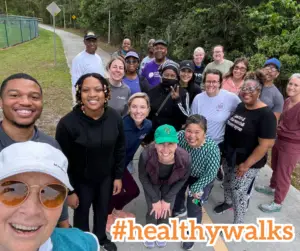What is Health Equity and Why It is So Important
Health equity is the state in which everyone has a fair and just opportunity to attain their highest level of health. That may sound simple, but it is not, because many factors contribute to a person’s health. An affordable, high-quality place to live matters. So do a safe neighborhood, educational opportunities, enough food to eat, a job that pays a “living wage,” a life free of discrimination and access to high-quality, comprehensive health care. Any or all of these factors can make health equity seem even more challenging.
The factors that affect health equity are call the Social Determinants of Health. These are the conditions in the places where people live, learn, work, play, and worship that affect a wide range of health risks and outcomes. Long-standing inequities in key areas of social determinants of health are interrelated and influence a wide range of health and quality-of-life risks and outcomes. These include:
- Safe housing, transportation, and neighborhoods
- Racism, discrimination, and violence
- Education, job opportunities, and income
- Access to nutritious foods and physical activity opportunities
- Polluted air and water
- Language and literacy skills
The Social Determinants of Health also contribute to wide health disparities and inequities. For example, people who don’t have access to grocery stores with healthy foods are less likely to have good nutrition. That raises their risk of health conditions like heart disease, diabetes, and obesity — and even lowers life expectancy relative to people who do have access to healthy foods.
Health equity is therefore important because health influences happiness and overall well-being, so it’s only logical that everyone should get the opportunity to be as healthy as possible. To achieve this it involves breaking down barriers—such as discrimination and lack of resources— that lead to those inequalities; it means recognizing that some demographics require additional resources and opportunities in order to reach their full health potential.
Does your Family Have Access to Enough Healthy Food?
Food and nutrition insecurity is a term to describe when someone is unable to access or afford enough food or enough nutritious food for their overall health and well-being. Food and nutrition insecurity doesn’t always mean that someone goes without food; it can mean that they’re not getting the healthiest kind of food. This can be because nutritious foods may be hard to find in some communities or because they can be too expensive for many to afford.
 Most food and nutrition insecurity problems are related to social determinants of health, such as income, employment, race/ethnicity, and disability. The risk for food insecurity increases when money to buy food is limited or not available. In 2020, 28.6 percent of low-income households were food insecure, compared to the national average of 10.5 percent.
Most food and nutrition insecurity problems are related to social determinants of health, such as income, employment, race/ethnicity, and disability. The risk for food insecurity increases when money to buy food is limited or not available. In 2020, 28.6 percent of low-income households were food insecure, compared to the national average of 10.5 percent.
Unemployment can also negatively affect a household’s food security status. High unemployment rates among low-income populations make it more difficult to meet basic household food needs. In addition, children with unemployed parents have higher rates of food insecurity than children with employed parents. Disabled adults may be at a higher risk for food insecurity due to limited employment opportunities and health care-related expenses that reduce the income available to buy food.
Racial and ethnic disparities exist related to food insecurity. In 2020, Black non-Hispanic households were over two times more likely to be food insecure than the national average. Among Hispanic households, the prevalence of food insecurity was 17.2%, compared to the national average of 10.5%. Potential factors influencing these disparities may include neighborhood conditions, physical access to food, and lack of transportation.
Neighborhood conditions may affect physical access to food. For example, people living in some urban areas, rural areas, and low-income neighborhoods may have limited access to full-service supermarkets or grocery stores. Access to healthy foods is also affected by lack of transportation and long distances between residences and supermarkets or grocery stores. Lack of access to public transportation or a personal vehicle limits access to food. Groups who may lack transportation to healthy food sources include those with chronic diseases or disabilities, residents of rural areas, and some racial/ethnicity groups
Adults and children who are food insecure may be at an increased risk for a variety of negative health outcomes and health disparities, such as an increased risk of obesity and higher rates of chronic diseases.
These causes make it hard to solve food and nutrition insecurity. The good news is that there are many programs at the national, state, and local levels that can provide food assistance. Food assistance programs, such as the National School Lunch Program (NSLP); the Women, Infants, and Children (WIC) program; and the Supplemental Nutrition Assistance Program (SNAP), address barriers to accessing healthy food.
Read more:
- Coastal Georgia Indicators Coalition (The Chatham Family Connection Collaborative): https://www.coastalgaindicators.org/
- Food and Nutrition Insecurity and Diabetes: Understanding the Connection, Centers for Disease Control and Prevention: https://www.cdc.gov/diabetes/library/features/diabetes-and-food-insecurity.htm
- Food Insecurity, Healthy People 2030: https://health.gov/healthypeople/
Feeding your Household on a Small Budget: How to Plan and Shop Smart
Eating healthy when money is tight can be challenging, especially if you are living with a costly chronic health condition. A diet that includes plenty of vegetables, fruits, and lean proteins is important for good health, but the cost of nutritious foods can quickly add up. Eating on a budget doesn’t mean you have to sacrifice nutrition. With a little know-how and planning, you can enjoy nutritious foods without breaking the bank.
By following these five tips, you may be surprised at how much you can stretch your grocery budget
Before going shopping figure out how much money you have to spend on food for the week:
Come up with meal and snack ideas that fit your budget. Check to see what foods you already have. Look in your refrigerator, freezer and cabinets.
Check grocery sales flyers. See if you can plan a menu based on what is on sale
Get to know the stores in your neighborhood. You may find deals at ethnic markets, dollar stores, retail supercenters, wholesale clubs and farmers markets
Find out which fruits and vegetables are in season:
Produce that’s in season usually costs less and they can be preserved for when they are out of season.

Make a shopping list:
Write down everything you need to buy from the grocery store. Having a shopping list makes shopping easier and faster, which helps you reduce impulse buys and take home only the items you need.
It also helps you avoid extra trips to the grocery store to buy forgotten items.
If your shopping list includes nuts, beans, or grains, consider buying in bulk to save money and keep your pantry well-stocked for future meal planning.
Once you are at the store:
Get to know your grocery store layout and skip the snack and soda isles especially if you have children with you.
Try store brands of different foods if they cost less
Compare unit prices listed on shelves for best value. If you have a large to feed or extra freezer space, buy the larger size or family packs if the unit cost is less.
Check use by or expiration dates. Stores usually stock shelves with the newest items behind the older ones. Reach in the back for the freshest items, especially in the produce, dairy, and meat aisles.
Buy frozen or canned foods when needed, they cost less and last longer than fresh produce.
When choosing canned options, it’s best to select those that come in water, not syrup.
Be sure to read the label for any added sugar or salt. You’ll want to avoid those.
And skip frozen options that have added butter or cream sauces. Choose options without sauce or look for packaging that reads “lightly sauced” to avoid extra sugar, salt, and empty calories.
Try growing your own garden:
Growing your own fruits and vegetables is a great way to save money and have fresh produce at your fingertips. Even if you don’t have a yard to grow a garden, many fruits, vegetables, and herbs can grow in pots on patios or balconies.
Having a constant supply of fresh produce at home can save you money at the store. You may not be able to grow a “money tree” in your garden, but it’ll feel like you did with the extra money you’ll be saving.
You can feed your family healthy meals on a budget, but it helps to have a plan. Here are some other tips from MyPlate.gov on how to plan and shop on a budget. Try all the tips or start with a few tips. Every effort counts towards feeding your family right!
Read more at https://www.healthychildren.org/
Benefits of Buying Local
If you’ve ever stopped by your neighborhood farmers market, the bountiful bunches of kale, locally crafted cheeses, seasonal fruits, and freshly baked bread are all results of a local food economy.
 Eating local means enjoying more locally grown produce and other foods from farmers and producers in your community. Buying local meat, produce and other food products can help you eat healthier, stay informed and save money. It also has larger impacts on those around you, benefiting the local economy and environment. Each time you support local food producers and sellers, you help build a healthier local economy, stronger community and more sustainable environment. You can find local foods at farmers’ markets and even grocery stores with a little bit of searching
Eating local means enjoying more locally grown produce and other foods from farmers and producers in your community. Buying local meat, produce and other food products can help you eat healthier, stay informed and save money. It also has larger impacts on those around you, benefiting the local economy and environment. Each time you support local food producers and sellers, you help build a healthier local economy, stronger community and more sustainable environment. You can find local foods at farmers’ markets and even grocery stores with a little bit of searching
Benefits of buying local:
Better Taste. Closer to home = fresher! Think of a perfectly ripened, juicy summer tomato or crisp fall apple. Yum!
Cost savings. Buying locally and in season means bigger harvests and less transport costs.
More sustainable food environment. Supporting local produce means more money right here in our local economy. This keeps our carbon footprint lower and supports a healthy environment.
Less waste and plastic packaging. A lot of local foods, especially produce, are sold at farm stands without packaging. Plus, you can bring your own reusable bags to carry the items home.
Where to buy local:
Forsyth Farmers’ Market – Open every Saturday at the south end of Forsyth Park from 9 a.m. to 1 p.m., you can find locally grown produce, meats, and dairy products. They even have fun activities for children like the Power of Produce Club.
Farm Truck 912 – A mobile version of the Forsyth Farmers’ Market will be ready to roll later this year. Look for it coming to a neighborhood near you!
Wilmington Island Farmers’ Market – Also open every Saturday, rain or shine, at Islands Community Church, you will find many local vendors and family-friendly activities, including a healthy kids club.
Your local grocery store – Georgia boasts a plentiful harvest all year long. Keep an eye out for apples, broccoli, carrots, collards and other greens, sweet potatoes, winter squash and more this month.
Physical Activity
Making Physical Activity a Part of a Child’s Life
As a parent, you can help shape your child’s attitudes and behaviors regarding physical activity. The CDC recommends that you should encourage your child to be physically active for 60 minutes or more each day, with activities ranging from informal, active play to organized sports.

Regular physical activity has lots of health benefits for children and adolescents, such as: improving fitness, providing an opportunity to socialize, increasing concentration, improving academic scores, building a stronger heart, bones and healthier muscles, encouraging healthy growth and development, improving self-esteem, improving posture and balance, lowering stress, encouraging a better night’s sleep.
Young children love to play and be active. Encouraging lots of safe and unstructured movement and play can help build a strong foundation for an active lifestyle.
Set a positive example by leading an active lifestyle yourself.
Make physical activity part of your family’s daily routine by taking family walks or playing active games together.
Give your children equipment that encourages physical activity.
Instead of watching television after dinner, encourage your child to find fun activities to do on their own or with friends and family, such as walking, playing chase, or riding bikes.
What Opportunities for Exercise are Available near You
 Exercise and physical activity are great ways to feel better, boost your health and have fun. For most healthy adults, the U.S. Department of Health and Human Services recommends getting at least 150 minutes of moderate aerobic activity. Or get at least 75 minutes of vigorous aerobic activity a week. You also can get an equal combination of moderate and vigorous activity, but aim to spread out this exercise over a few days or more in a week.
Exercise and physical activity are great ways to feel better, boost your health and have fun. For most healthy adults, the U.S. Department of Health and Human Services recommends getting at least 150 minutes of moderate aerobic activity. Or get at least 75 minutes of vigorous aerobic activity a week. You also can get an equal combination of moderate and vigorous activity, but aim to spread out this exercise over a few days or more in a week.
But where can you go to exercise?
Proximity to exercise opportunities, such as parks and recreation facilities, has been linked to an increase in physical activity among residents. Residents in Savannah, Georgia struggle to meet recommended physical activity guidelines. The lack of safe and accessible spaces to engage in outdoor physical activities presents a significant obstacle. Here are a few ideas:
 Tide to Town, a planned 30-mile network of walking and biking trails, will provide protected spaces for physical activity and serve an important role in transportation. The early phases of Tide to Town are complete and open to the public, the first three miles are at the Truman Linear Park Trail.
Tide to Town, a planned 30-mile network of walking and biking trails, will provide protected spaces for physical activity and serve an important role in transportation. The early phases of Tide to Town are complete and open to the public, the first three miles are at the Truman Linear Park Trail.
Healthy Savannah hosts a weekly Tuesday Healthy Walks at 7.30 am to introduce the Savannah community to safe local trials and pathways. The goal is to highlight the places where Chatham County residents will be able to engage in safe physical activity. Why not join them this coming Tuesday.
The Walking School Bus, Healthy Savannah has collaborated with SCCPSS to launch school buses at several locations throughout the City of Savannah and offer students a safe way to walk to school and be physically active. A walking school bus is a group of children walking to school with one or more adults, a variation on the walking school bus is a bicycle train where a group of children and adult leaders ride together to school.
Maternal Health
Taking Care of Yourself During Those Nine Months
 Maternal health refers to the health of women during pregnancy and the postpartum period. Some women may have health problems that can arise before or during pregnancy. These health challenges can lead to pregnancy complications and impact infant health and include diabetes, hypertension, and depression. In addition, alcohol, smoking and other substance misuse during pregnancy can significantly impact you and your baby’s health. One of the impact using such substances can have is on your baby, increasing the risk for having an infant with low birthweight.
Maternal health refers to the health of women during pregnancy and the postpartum period. Some women may have health problems that can arise before or during pregnancy. These health challenges can lead to pregnancy complications and impact infant health and include diabetes, hypertension, and depression. In addition, alcohol, smoking and other substance misuse during pregnancy can significantly impact you and your baby’s health. One of the impact using such substances can have is on your baby, increasing the risk for having an infant with low birthweight.
What is low birthweight?
Low birthweight is when a baby is born weighing less than 5 pounds, 8 ounces. Some babies with low birthweight are healthy, even though they’re small. But having a low weight at birth can cause serious health problems for some babies. A baby who is very small at birth may have trouble eating, gaining weight and fighting off infections. Some may have long-term health problems, too. About 1 in 12 babies (about 8 percent) in the United States is born with low birthweight.
Some low-birthweight babies are healthy, but others have serious health problems that need treatment. Premature birth (before 37 weeks of pregnancy) and fetal growth restriction are the most common causes of low birthweight.
Being a person of color is not a cause for having a low birthweight baby. However, communities of color are disproportionately affected by racism. This affects their health and well-being and increases the risk of pregnancy complications. Nationally, non-Hispanic Black infants are almost twice as likely to be born with low birthweight. Educating the public and health care providers, broadening access to quality health care services, promoting healthier physical and social environments, supporting innovative research, and advocating for efforts to address racial and social inequalities can be effective tools in reducing disparities in preterm births and low birthweight
Go to all your prenatal care checkups during pregnancy. Your health care provider tracks your baby’s growth and development at each visit.
Talk with your provider about what you can do to help reduce your risk for having a baby with low birthweight
Breastfeeding is Nature’s Health Plan
Breastfeeding has health benefits for both babies and mothers. Breast milk contains all the nutrients an infant needs in the first six months of life and remains an important food during the first year of a baby’s life.

Evidence suggests that initiation of breastfeeding in the first day of life is associated with a significant reduction in the risk of neonatal mortality when compared with delaying breastfeeding for more than 24 hours after birth. The World Health Organization (WHO) recommends that low birth-weight (LBW) infants who are able to breastfeed should be put to the breast as soon as possible after birth when they are clinically stable, and should be exclusively breastfed until six months of age.
Five Great Benefits of Breastfeeding
Breast milk is the best source of nutrition for most babies.
As the baby grows, the mother’s breast milk will change to meet the baby’s nutritional needs.
Breastfeeding can help protect babies against some short- and long-term illnesses and diseases.
Breastfed babies have a lower risk of asthma, obesity, type 1 diabetes, and sudden infant death syndrome (SIDS). Breastfed babies are also less likely to have ear infections and stomach bugs.
Breast milk shares antibodies from the mother with her baby.
These antibodies help babies develop a strong immune system and protect them from illnesses.
Mothers can breastfeed anytime and anywhere.
Mothers can feed their babies on the go without worrying about having to mix formula or prepare bottles. When traveling, breastfeeding can also provide a source of comfort for babies whose normal routine is disrupted.
Breastfeeding can reduce the mother’s risk of breast and ovarian cancer, type 2 diabetes, and high blood pressure.
Breastfeeding has health benefits for the mother too! Some cancers, type 2 diabetes, and high blood pressure are less common among women who breastfeed.
Vaccinations
Let’s Play Catch-Up On Routine Vaccines
Has your child missed check-ups and recommended childhood vaccinations over the past few years? CDC and the American Academy of Pediatrics (AAP) recommend children catch up on routine childhood vaccinations and get back on track for school, childcare, and beyond. On-time vaccination throughout childhood is essential because it helps provide immunity before children are exposed to potentially life-threatening diseases. Vaccines are tested to ensure that they are safe and effective for children to receive at the recommended ages.

Reason’s to follow CDC’s recommended immunization schedule:
Ideal timing
The immunization schedule is carefully designed to provide protection at just the right time. This ensures your little one is protected from 14 potentially serious diseases at exactly the right time
Prevent complications
While babies are born with some immunity, they have not yet built up the necessary defenses against the diseases that vaccines prevent. Delaying vaccines could leave your child vulnerable to disease when she’s most likely to have serious complications.
Early protection
It’s best to vaccinate before your child is exposed to dangerous diseases. It can take weeks for a vaccine to help your baby make protective disease-fighting antibodies, and some vaccines require multiple doses to provide best protection. If you wait until you think your child could be exposed to a serious illness – like when he starts daycare or during a disease outbreak – there may not be enough time for the vaccine to work. That is why paying attention to the scheduled timing is important.
Best protection
Each vaccine is carefully developed to protect against a specific illness. Some require more than one dose to build strong enough immunity to protect your child, or to boost immunity that decreases over time. Others need additional doses to ensure your child is protected in case the first dose didn’t produce enough antibodies. Therefore every recommended dose of each vaccine on the schedule is important.
Spreading diseases
Children who are not vaccinated on schedule are not only at risk of getting sick themselves, but they can also spread illness to others who aren’t protected, like newborns who are too young for vaccines and people with weakened immune systems. By getting your child’s vaccines on time you’re not only protecting your baby — you’re helping to protect your friends, family, and community, too.
See which vaccines your child needs from birth through age 6 in this parent-friendly immunization schedule: https://www.cdc.gov/vaccines/schedules/easy-to-read/child-easyread.html
See which vaccines your child needs from ages 7 through 18 in the parent-friendly immunization schedule: https://www.cdc.gov/vaccines/schedules/easy-to-read/adolescent-easyread.html

